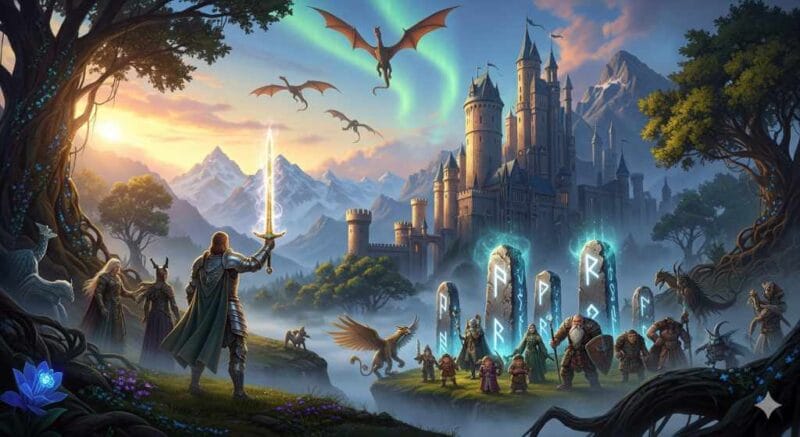An epilogue may seem like the final note of a story, but it functions as a bridge between the conclusion and what follows. It extends beyond the ending and provides a space where the story’s impact remains. Instead of closing every thread, it acknowledges that change continues and creates room for reflection on past events and future possibilities.
It appears at the end of a work and reveals the aftermath of events and the fate of the characters. At the same time, it reinforces the themes that governed the narrative. More than an addendum, it serves as a meaningful extension that links the story’s resolution to its broader implications. It leaves a lasting impression rather than a simple conclusion.
Historical Context and Evolution
Throughout history, writers used epilogues to refine their endings. In classical Greek drama, the Chorus delivered final reflections that framed the sequence of events and left the audience with a lasting impression. During the Restoration period, brief concluding remarks provided a witty coda to the performance and connected the stage to the realities of daily life. Over the centuries, this device shifted from a simple recap to a structured commentary that deepened the meaning of a work.
Functions and Forms
An epilogue serves several distinct purposes. It may:
- Resolve remaining plot threads.
- Provide a reflective update on characters’ paths after the climax.
- Suggest future developments without compromising the integrity of the completed story.
Instead of repeating what the story already established, a well-crafted epilogue adds depth by linking past events to their long-term consequences. It creates an opportunity to revisit and reinterpret earlier actions and encourages the audience to consider the lasting effects of the narrative.
Stylistic Approaches
The tone and style of an epilogue often contrast with the main body of the work. Some authors adopt a reflective, meditative voice that revisits past events with a sense of closure. In F. Scott Fitzgerald’s The Great Gatsby (1925), the final reflections present a calm, retrospective analysis that stands in contrast to the urgency of the preceding pages.
Other writers take a forward-looking approach that outlines the future. In J. K. Rowling’s Harry Potter and the Deathly Hallows (2007), the last section shifts focus to the characters’ lives years after the central conflict, showing that their world moves forward with both promise and uncertainty.
These shifts in tone or perspective serve a purpose. They encourage the audience to reconsider earlier events while offering a sense of continuation. The contrast between the main narrative and the final section strengthens the work’s overall impact, which provides a meaningful closing statement.
Balancing Closure and Continuation
An epilogue should offer a sense of completion without erasing the ambiguity that makes a story memorable. It must tie up unresolved elements without simply rehashing earlier details or resorting to overt sentimentality.
Striking the right balance between providing closure and hinting at future possibilities is a key challenge in writing an epilogue. When executed successfully, the final pages provide a seamless transition from a concluded account to an open-ended reflection on what comes next.
This balance is essential. An epilogue that is too definitive may limit the audience’s engagement with the work beyond its final words, while one that is excessively vague risks leaving too many questions unanswered. The goal is to complete the account in such a way that it encourages further contemplation while providing a satisfying finish.
Genre-Specific Applications
Different genres harness the epilogue in unique ways. In mystery or crime fiction, the final section might offer the last piece of evidence or a twist that reinterprets earlier events. In romance, an epilogue often charts the evolution of a relationship, showing the characters thriving long after the central conflict has ended. Science fiction and fantasy works frequently use epilogues to sketch a broader future, sometimes hinting at subsequent sagas or spin-offs. This versatility makes the epilogue a valuable tool across various forms of storytelling.
Advantages and Drawbacks
The inclusion of an epilogue carries both benefits and risks. On the positive side, it can:
- Resolve lingering questions and deliver a clear conclusion to complex storylines.
- Provide clarity on characters’ fates, helping the audience grasp the long-term consequences of key events.
- Extend the work’s influence by linking the immediate conclusion to broader future developments.
However, an epilogue is not without its challenges. A poorly executed final section can feel redundant or overly sentimental, detracting from the strength of the main story. If it reiterates information already presented or lacks a fresh perspective, the epilogue may come across as an unnecessary afterthought rather than an integral part of the work.
Writers must be cautious. The timing, tone, and content of the epilogue must be carefully calibrated to reinforce the main storyline rather than undermine it. This demands a delicate touch and an acute awareness of the work’s overall arc.
Notable Examples in Literature
Numerous works have demonstrated the effective use of epilogues. Consider these examples:
- F. Scott Fitzgerald’s The Great Gatsby (1925):
The final reflective passages provide a calm analysis of past events, which offer a counterpoint to the novel’s frenetic energy. It has a final, reflective chapter that serves as an epilogue, pondering the themes of the past, dreams, and the American Dream. - J. K. Rowling’s Harry Potter and the Deathly Hallows (2007):
The closing section shifts the focus to the future by showing that the characters’ lives continue beyond the climactic battle. It famously has an epilogue set “Nineteen Years Later,” showing the main characters as adults seeing their own children off to Hogwarts. - George Orwell’s Animal Farm (1945):
The final scene, where the pigs become indistinguishable from the humans, serves as a powerful, albeit somewhat integrated, epilogue that underscores the novel’s allegorical message. It’s a concluding commentary rather than a separate section labeled “Epilogue.” - Charlotte Brontë’s Jane Eyre (1847):
The final chapter (Chapter 38) functions as an epilogue. It summarizes the events after the main climax and describes Jane’s marriage to Rochester and their life together, which gives the story a clear sense of closure and resolution. - Margaret Atwood’s The Handmaid’s Tale (1985):
It has a section called “Historical Notes” at the end, which is a transcript of a symposium taking place in the future, discussing the events of the novel as a historical period. This functions as an epilogue, providing a broader perspective and context. - Ann Patchett’s Bel Canto (2001):
Following the resolution of the tense hostage crisis, the concluding section explores its long-term effects and the resulting changes in the relationships of those involved. - Cormac McCarthy’s Blood Meridian (1985):
An enigmatic final scene leaves much to interpretation. It includes a brief, enigmatic final section following the Judge’s last encounter with the kid (now “the man”)—one that presents an image of a solitary figure whose actions evoke both creation and destruction.
These examples illustrate the range of functions that epilogues can serve. The final section of a work can enhance the overall narrative, moving from clear resolution toward the open ground of future possibility, to provide a conclusion that lingers in the mind.
Further Reading
Is It Really Over? To Epilogue or Not to Epilogue by kayedacus.com




